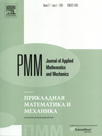 | | Journal of Applied
Mathematics and Mechanics
Russian Academy of Sciences | | Founded
in January 1936
(Translated from 1958)
Issued 6 times a year
ISSN 0021-8928
(print version) |
Archive of Issues
| Total articles in the database: | | 10482 |
| In Russian (¤╠╠): | | 9683
|
| In English (J. Appl. Math. Mech.): | | 799 |
|
| << Previous article | Volume 74, Issue 3 / 2010 | Next article >> |
| A.V. Gavrilov and I.V. Shirko, "Fluid flow in an inhomogeneous granular medium," J. Appl. Math. Mech. 74 (3), 267-277 (2010) |
| Year |
2010 |
Volume |
74 |
Issue |
3 |
Pages |
267-277 |
| Title |
Fluid flow in an inhomogeneous granular medium |
| Author(s) |
A.V. Gavrilov (Moscow, Russia, embidex@mail.ru)
I.V. Shirko (Moscow, Russia, shirko@career.mipt.ru) |
| Abstract |
The seepage of a compressible fluid in an inhomogeneous undeformable granular medium is investigated. It is assumed that the fluid flow in a porous space is described by the Navier-Stokes equations. It is shown that, in the case of an inhomogeneous velocity field, a tensor of additional effective stresses occurs in connection with the transfer of fluid particles in a transverse direction when flow occurs around the granules of the medium in a longitudinal direction. Using the fundamental propositions of Reynoldsĺ averaging theory and Prandtl's mixing path, the structure of the effective viscosity coefficient is determined and hypotheses are formulated which enable it to be assumed to be independent of the flow velocity. It is established by comparison with experimental data that the effective viscosity coefficient can exceed the viscosity coefficient of the flowing fluid by an order of magnitude. The equations of average motion are obtained, which in the case of an incompressible fluid have the form of the Navier-Stokes equations with body forces proportional to the velocity. It is established that, in addition to the well-known dimensionless flow numbers, there is a new number which characterizes the ratio of the Darcy porous drag forces to the effective viscosity forces. The proposed equations are extended to the case of the flow of an aerated fluid. The components of the angular momentum vector are used as the required functions instead of the components of the velocity vector. This enables a solving system of equations to be obtained, which, apart from the notation, is identical with the similar equations for the case of an incompressible fluid. The solution of a new problem of the fluid flow in a plane channel with permeable walls is presented using three models: Darcy's law for an incompressible and aerated fluid, and also of an aerated fluid taking the effective viscosity into account. It is established that, for the same pressure drop, the maximum flow rate corresponds to Darcy's law. Compressibility leads to its reduction, but by simultaneously taking into account the compressibility and the effective viscosity one obtains minimum values of the flow rate. The effective viscosity and aeration of the fluid has a considerable effect on the flow parameters. |
| Received |
22 September 2008 |
| Link to Fulltext |
|
| << Previous article | Volume 74, Issue 3 / 2010 | Next article >> |
|
 If you find a misprint on a webpage, please help us correct it promptly - just highlight and press Ctrl+Enter If you find a misprint on a webpage, please help us correct it promptly - just highlight and press Ctrl+Enter
|
|

 Russian
Russian  English
English